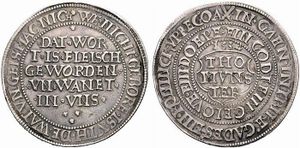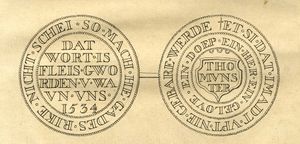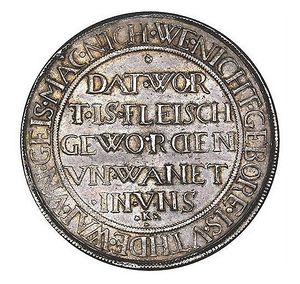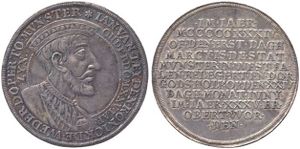Anabaptist Coinage and Commemorative Medals (Münster, Nordrhein-Westfalen, Germany)
Introduction
The German Hanseatic city of Münster located in Nordrhein-Westfalen, Northwest Germany was engaged in much religious turmoil early in the Reformation. In the years 1532-1535 it became a centre of radical Anabaptism when many persecuted religious reformers found refuge in the city. From February 1534 to June 1535 the city was under the control of revolutionary Anabaptists who oversaw all city administrative functions which included commerce and the minting of coins.
Early in the 1500s the silver Thaler coin came into general usage throughout much of Europe which needed a common coinage for interstate commerce. Many different German states and other European countries minted their own Thaler coins. Though, over time, there was some variation in the size and weight of the Thaler, it remained a standard coin of about 29 grams of silver and about 41 millimeters in diameter for over 400 years. These coins are about 10% larger than the USA silver dollar.
Münster Anabaptist Coins
The Münster Anabaptists minted two types of coins during their control of the city in the values of one and one-half Thalers. The coins contain no indication of their value; only their sizes and weights are identical to other circulating one and one-half Thaler coins.
These coins were unusual for several reasons. First, the coins were to serve to propagate Anabaptist ideas and to inform others of their success in Münster. For this purpose they contain the mottos of the Anabaptists in the German vernacular of the day. Further, they were to be circulated only outside of the city. These coins had no function in the city as the Anabaptist city leaders had banished the use money in the city; people’s needs were met by sharing and communal distribution. Visually, the coins differ from all of the other coins in circulation at that time in that they bear only writing and no personal images whatsoever. The design of the coins reflected the Anabaptist message as well as the idea of the Reformation with its rejection of clerical or civil pomp.
| Side A (Reading from the inside out) DAT WORT IS FLEISCH GEWORDEN VN WANET IN UNS (The Word became flesh and dwelt among us) These two Bible texts, the first from John 1:14 and the other from John 3:5, were favorite texts of Anabaptist and probably well known to the general public. The John 3:5 text is truncated with the words: "enter the kingdom of God" omitted. Side B | |
| Side A (Reading inside out) DAT WORT IS FLEIS GWORDEN V WAUN VNS (The Word became flesh and dwelt among us [John 1:14]) This text finished the truncated text, John 3:5, from side B of the one Thaler coin. Side B |
Max Geisberg in his detailed study of these coins identifies eighteen variation in the different dies used to stamp the one Thaler coins and two different dies for the one-half Thaler coin. The text on some coins from the various dies show slight variation. In addition to silver some examples exist of these coins in gold or cast bronze. Geisberg also speculates that the total number of coins actually minted and distributed by the Anabaptists was small. This was because shortly after the Anabaptist began ruling the city it was cut off, besieged, and no one was permitted to leave. After the fall of Münster, however, coins in storage and the original dies were seized and used by the conquerors to mint many more copies of the coins -- most likely as souvenirs and also probably used to pay the mercenary soldiers.
These coins have now become quite rare and are popular with collectors and writers on numismatics.
Commemorative Coins
About 100 years after the fall of the Anabaptist rule of Münster and before or during the three years of negotiations leading up to the signing of the Peace of Westphalia Treaty that ended the Thirty Years War, the dies for the coins were again recovered. These dies were then used to reissue the coins because many of the delegates to the peace treaty wanted a souvenir of some kind to commemorative the city of Münster. In addition at least one die set was either reworked or a replica made to issue these coins as souvenirs. An example from this reworked die is illustrated below. One feature to identify some of the reissued coins is to find a symbol or letter, often the letter "k" between the three stars near the bottom of the one Thaler coin.
Commemorative Medal of Jan van Leiden also known as Jan Beukelszoon (1509-1536)
A short time after the recapture of the city of Münster and the imprisonment of the Anabaptist leaders, Count Franz von Waldeck, who was Münster’s temporal Lord and also its restored Catholic Bishop, engaged the artist Heinrich Aldegrever (1502-1561) to make a copper engraving likeness of Jan Beukelszoon, also called Jan van Leiden for he came to Münster from the Dutch city of Leiden, as King of Münster. A commemorative one Thaler sized medal featuring a portrait of Jan Beukelszoon based on the final copper engraving by Aldergrever was issued. Like the engraving Jan is depicted as a dignified, intelligent young man. Max Geisberg pointed out that the portrait used was not Aldergrever’s first sketch since it shows Jan with a sceptre which is missing from Aldgrever’s earliest drawing. Also the text uses the south German word "ZO" as in "ZO MONSTER" [translated as: "in Münster"] in place of the north German word "THO." This is evidence that this medal was made sometime after the fall of Münster and perhaps not in Münster. Though this medal is undated and little is known of its actual minting but it was probably issued within a few years after 1536. Copies with small variation exist indicating that several dies were made for minting this medal. This medal is depicted in an engraving of Anabaptist coins in Bernard Picart’s Cérémonies et coutumes religieuses de tous les peuples du monde, (Amsterdam 1723-1743).
| Side A (Inside out) Jan van Leiden in royal robes with a scroll in his right hand and sceptre in the crook of his left arm. Side B |
In size this medal is 41.71mm and weighs 24.27 grams. This is very similar to the size and weight of a one Thaler coin.
1728 Jan van Leiden Commemorative Medal
Ever since the destruction of the Anabaptist control of Münster in 1535 a very large corpus of writings have been issued on that subject and most of these also comment on the coins and often contain illustration of them. This fascination with the Anabaptists of Münster also resulted in a commemorative medal which was minted in Nuremburg, Germany, around 1728 with a portrait of Jan van Leiden in profile. In Münster Jan Beukelszoon was known as Jan van Leiden.
| Side A (Reading from the inside out) Jan van Leiden (Jan Beuckelzoon) portrait wearing decorative cap and orb; Side B |
Four hundred years later the Anabaptist control of Münster was again commemorated in 1921 when the City of Münster issued a set of five different emergency Notgeld banknotes each one commemorating a different aspect of the Anabaptist control of the city. See Paper Money and Notgeld with Anabaptist Mennonite Themes for information on those Notgeld pieces.
Bibliography
Geisberg, Max. Die Münsterischen Wiedertäufer und Aldergrever: eine ikonographische und numismatische Studie. Strassburg, Germany: J.H. Ed. Heitz (Heitz & Mündel), 1907.
| Author(s) | Victor G Wiebe |
|---|---|
| Date Published | September 2015 |
Cite This Article
MLA style
Wiebe, Victor G. "Anabaptist Coinage and Commemorative Medals (Münster, Nordrhein-Westfalen, Germany)." Global Anabaptist Mennonite Encyclopedia Online. September 2015. Web. 16 Apr 2024. https://gameo.org/index.php?title=Anabaptist_Coinage_and_Commemorative_Medals_(M%C3%BCnster,_Nordrhein-Westfalen,_Germany)&oldid=133200.
APA style
Wiebe, Victor G. (September 2015). Anabaptist Coinage and Commemorative Medals (Münster, Nordrhein-Westfalen, Germany). Global Anabaptist Mennonite Encyclopedia Online. Retrieved 16 April 2024, from https://gameo.org/index.php?title=Anabaptist_Coinage_and_Commemorative_Medals_(M%C3%BCnster,_Nordrhein-Westfalen,_Germany)&oldid=133200.
©1996-2024 by the Global Anabaptist Mennonite Encyclopedia Online. All rights reserved.




